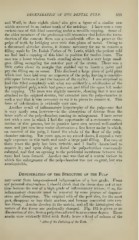Page 849 - My FlipBook
P. 849
DEGENERATION OF THE DENTAL PULP. 859
and Wedl, in their eighth plate/ also give a figure of a similar case
which occurred in an incisor tooth of the antelope. I have seen a very
curious case of this kind occurring under a metallic capping. Some of
the older members of the profession will remember that before the intro-
duction of the cements there was a considerable effort to preserve the
pulps of teeth by bridging over with thin plates of metal. Owing to
a threatened alveolar abscess, it became necessary for me to remove a
filling made by Dr. Isaiah Forbes of St. Louis, which the patient told
me had had a capping of this kind in position for twelve years. The
case was a lower wisdom tooth standing alone, with a very large amal-
gam filling occupying the anterior part of the crown. There was a
little caries about its margin that enabled me to insert a point and
pry the filling out en masse. This disclosed a large piece of gold plate
which had been laid over an exposure of the pulp, leaving a consider-
able space between it and the bottom of the cavity. I was surprised to
find this filled completely with what was evidently a calcification of the
hypertrophied pulp, which had grown out and filled the space left under
the capping. The mass was slightly movable, showing that it was not
attached to the original dentine, but extended into the pulp-chamber in
This
such a way that it was necessary to cut it to pieces to remove it.
form of calcification is evidently very rare.
Another result of inflammatory hypertrophy of the pulp—one that
is very rarely seen, however—is the absorption of dentine from the
inner walls of the pulp-chamber, causing its enlargement. I have never
met with a case in which I had the opportunity of a systematic exam-
ination of this process, but in practice have seen several well-marked
cases, and just now have under observation a first lower molar in which,
on removal of the pulp, I found the whole of the floor of the pulp-
chamber missing. Ten years ago, as my record shows, I capped a very
ugly exposure in this tooth and made a large gold filling. For two or
three years the pulp has been irritable, and I finally determined to
remove it ; and upon doing so found the pulp-chamber enormously
enlarged, and that an opening to the peridental membrane between the
roots had been formed. Another case was that of a central incisor in
which the enlargement of the pulp-chamber was not so great, but was
unmistakable.
-Degeneration op the Structure of the Pulp
may occur from long-continued inflammation of a low grade. From
my personal observations I should think that the tissue does not at any
time become the seat of a high grade of inflammatory action ; if so, the
inflammatory elements must be removed by some process of degener-
ation and absorption. The original cells of the part also, for the most
part, disappear or lose their nucleus, and become converted into very
fine fibres. Areolae develop in the matrix, and all the histological cha-
racters of the tissue are profoundly changed. Fig. 455 is given as an
illustration of this, from a pulp thus affected in an' extreme degree. These
areolae were evidently filled with fluid ; hence a kind of oedema of the
^ Atlas of the Paiholoyy of the Tteth,


